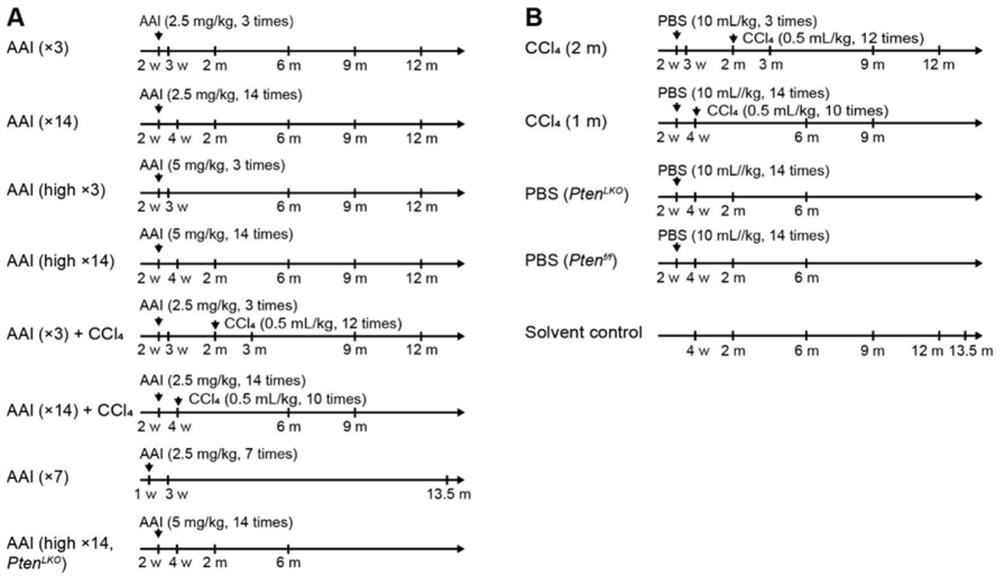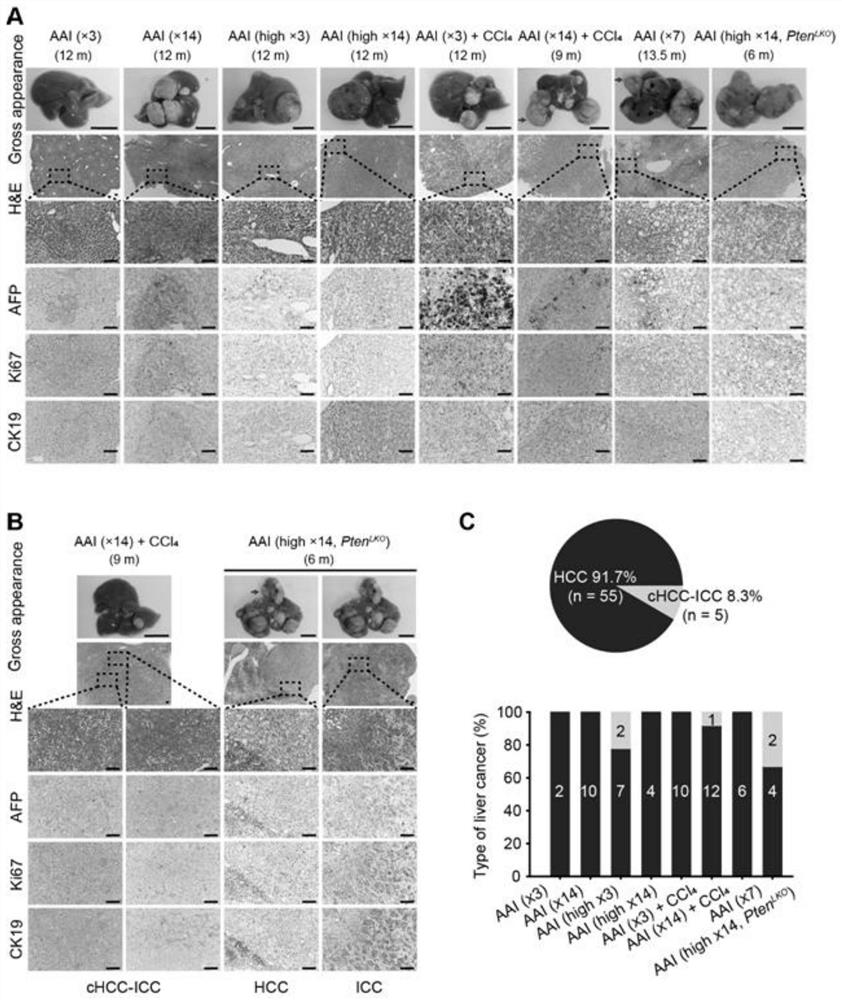Method for constructing mouse liver cancer model by using aristolochic acid I or combination of aristolochic acid I and carbon tetrachloride
A technology of aristolochic acid and carbon tetrachloride, applied in animal husbandry and other fields
- Summary
- Abstract
- Description
- Claims
- Application Information
AI Technical Summary
Problems solved by technology
Method used
Image
Examples
Embodiment 1
[0041] Embodiment 1, administering to mice by intraperitoneal injection
[0042] 1. Preparation of aristolochic acid I and carbon tetrachloride solution
[0043] 1.1 the aristolochic acid I solution with phosphate buffered saline (PBS) preparation concentration is 0.25 or 0.5mg / ml, carbon tetrachloride (CCl 4 ) is prepared as a 10% carbon tetrachloride solution with corn oil.
[0044]1.2 Put it in a 65°C water bath and heat for 20 minutes to sterilize.
[0045] 2. For C57 / BL6 wild-type male mice born at 1 week or 2 weeks or male mice with Pten liver-specific knockout (Pten gene with LoxP site mice (Pten f / f ) and Alb-Cre mice were purchased from Jackson Laboratory. Pten f / f Multigenerational mating with Alb-Cre to obtain homozygous Pten liver-specific knockout mice (Pten LKO ). ) carry out different times and different doses of aristolochic acid I administration, and for some wild-type mice wherein aristolochic acid I has been administered, carry out the carbon tetrach...
Embodiment 2
[0047] Embodiment 2, mouse anatomy and tumor statistics
[0048] Respectively select the mice after the treatment of each group in Example 1 for dissection and tumor statistics:
[0049] The mouse was anesthetized with isoflurane, and then the blood was collected from the eyeball. After the blood was allowed to stand at room temperature for 30 minutes, the supernatant was collected at room temperature at 5000 rpm for 30 minutes, aliquoted, and stored at -80°C.
[0050] The mice were killed by neck dissection, and the mice were fixed on the dissecting board for dissection, and the heart, liver, spleen, lung, kidney, brain, testis, ureter, bladder, stomach and tail were taken out, and the organs were observed for abnormalities. For the liver with liver cancer, each focal point was measured with a vernier caliper, and the number of focal points was counted, and the liver and kidney were weighed and photographed. The excised parts of each organ were placed in 4% paraformaldehyd...
Embodiment 3
[0053] Embodiment 3, pathological and histochemical determination of mouse liver cancer
[0054] 1 Tissue dehydration, embedding and sectioning
[0055] 1.1 After the tissue is fixed in 4% paraformaldehyde for 24 hours, dehydrate the tissue according to the following procedure:
[0056] Tap water rinse 10mim→50% ethanol 30min→60% ethanol 30min→70% ethanol 30min→80% ethanol 30min→90% ethanol 30min→95% ethanol 30min→95% ethanol 30min→100% ethanol 30min→100% ethanol 30min→none Water ethanol: xylene (1:1) 10min→xylene 5min→xylene 5min→paraffin 60°C 10min→paraffin 60°C 10min.
[0057] 1.2 Embed the wax-soaked tissue block with a paraffin embedding machine, cool it at -20°C, and store it at -20°C.
[0058] 1.3 Adjust the slice thickness of the paraffin microtome to 5 μm, slice and place in 42°C ddH 2 O to unfold the slices, and when fully stretched without wrinkles, scoop out the slices with an adhesive slide, place the slices on a 37°C oven for overnight, and store them at roo...
PUM
 Login to View More
Login to View More Abstract
Description
Claims
Application Information
 Login to View More
Login to View More - R&D
- Intellectual Property
- Life Sciences
- Materials
- Tech Scout
- Unparalleled Data Quality
- Higher Quality Content
- 60% Fewer Hallucinations
Browse by: Latest US Patents, China's latest patents, Technical Efficacy Thesaurus, Application Domain, Technology Topic, Popular Technical Reports.
© 2025 PatSnap. All rights reserved.Legal|Privacy policy|Modern Slavery Act Transparency Statement|Sitemap|About US| Contact US: help@patsnap.com



